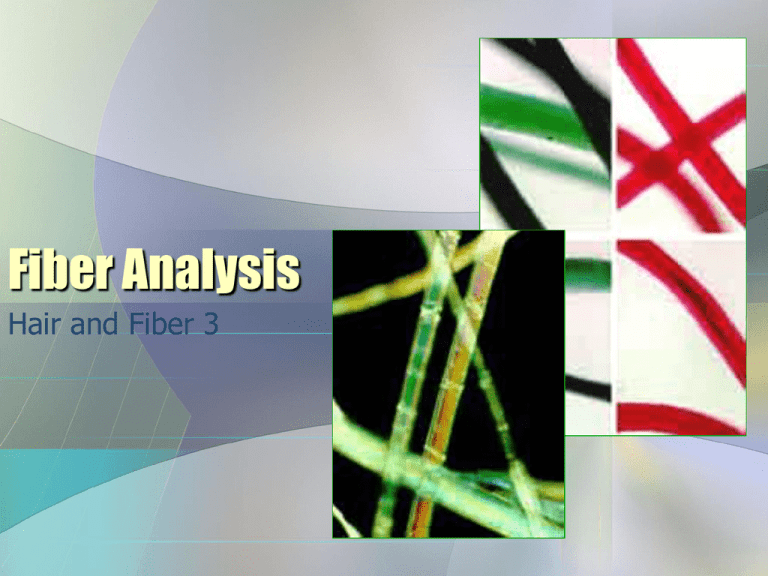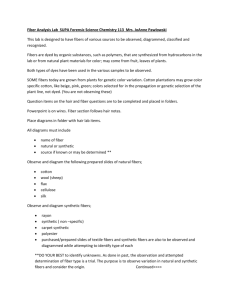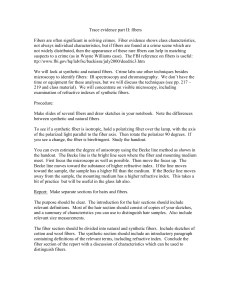Fiber Analysis
advertisement

Fiber Analysis Hair and Fiber 3 Fiber Evidence • Fiber – The smallest unit of a textile material that has a length many times greater than its diameter – Can be spun with other fibers to form a yarn (rope) that can be woven or knitted to form a fabric • Can be natural (plant or animal) or manmade – Man-made fibers now account for over ½ of all textile production Forensic Value • Are considered class evidence • Are common trace evidence at a crime scene • Can be characterized based on comparison of both physical and chemical properties Fiber Classification • Natural fibers are classified according to their origin – Vegetable or cellulose – Animal or protein – Mineral • Some natural fibers can be altered into artificial ones – Cotton and rayon – Rayon is chemically-altered cellulose Chemical Alteration Note the differences between the cotton fiber (left) and rayon (right). Can you detect what happens in the chemical transformation process? Fiber Evidence • Important characteristics – Type and length of fiber – Spinning method – Fabric construction • Above characteristics can greatly affect transfer of fibers and significance as evidence • Can originate from more than clothing – Furniture, upholstery, etc. Fiber Evidence • Significance – Based upon clear relationships between objects associated with crime – Relative value of evidence can be based upon several factors • Type of fiber • Number of fibers • Color or variation of color • Location of fibers • Number of different fibers • Likelihood of transfer based on fiber construction Fiber Evidence • Useful in similar crimes to hairs • Since DNA is not found, often limited to class characteristics due to mass production • Transfer usually found through physical contact • Routinely found in vehicle accidents or on glass/screens Animal Fibers •Silk –Technically a protein secretion –No longer found in nature –Among the most expensive fibers –Fibers are altered by changing diet of silkworm –Does not resemble typical non-human hair –Highly light reflective Mineral Fibers •Fiberglass –Artificially produced fiber •Asbestos –Natural fiber from the mineral serpentine Plant Fibers •Cotton –Most common plant fiber –Virtually worthless as evidence if white •If dyed, the dye is more valuable than the cotton –Distinctive twisted, ribbon-like shape Plant Fibers • Flax – Used to make linen – Distinctive lateral structures through fiber – Can be expensive Plant Fibers Ramie fiber, common in SE Asia Hemp fiber, the strongest natural fiber Plant fibers are based on the polymer cellulose, the chemical that forms the cell wall of plant cells Jute fiber, also common in Asia Synthetic Fibers • First introduced in 1911 (rayon) followed by nylon in 1939 • Hundreds of names currently used for essentially the same artificial fibers – Generally grouped into generic names • Example: Polyester - Sold under 28 different names Synthetic Fiber Chemistry • Based on polymers – Long chain molecules • Come in natural and man-made varieties • Synthetic polymers were first produced in 1909 – Originally discovered by accident • When a glass rod was removed from contact with polymer, it stretched and stuck to the rod. It hardened when cooled and would stretch into long filaments Synthetic Fiber Chemistry • Polymers – Well known natural polymers • Starch • Cellulose - nature of polymer provided structure to plants • Proteins - form animal hairs – Well known man-made polymers • Nylon • Teflon • Silicone • Vulcanized rubber Synthetic Fiber Chemistry • Man-made polymers – Basic chemical substance of all artificial fibers – Also include most paints, plastics, adhesives, rubbers • Polymers are routinely formed from thousands of individual atoms • Composed of repeating units called monomers that link like chains Synthetic Fiber Chemistry “Classic” polymer structure of the synthetic fiber nylon. Note the long chain of repeating atoms. Synthetic Fibers • In spite of common names, practically no two of the same type of fiber are manufactured the same way all the way through the production process • Positive ID almost always involves microscopy and chemical analysis Three different scanning electron microscope images of nylon carpet fibers. Note clear structural differences at this magnification. Synthetic Fiber Analysis • Identification and Comparison • Color – Based on introduced combinations of dyes – Different dyes may identify manufacturer • Diameter – Typically very little variation due to precise machinery – Cross section usually helpful as well • Production characteristics – Striations - almost always lengthwise – “Pitting” - occurs from particles added to fiber to reduce shine Typical cross section of synthetic carpet fibers. Synthetic Fiber Analysis •Production method can be single largest identifier •Cross sections are exceptionally important –Synthetic fibers are forced out of a nozzle when they are hot –Holes of the nozzle are not always round Synthetic Fiber Analysis • Burning • Chemistry of fibers can cause fiber to burn in different ways • Odor, color of flame, smoke and the appearance of the residue can also be an indicator • Thermal decomposition • Gently heating can break down polymers to basic monomers • Chemical testing • Solubility and decomposition Synthetic Fiber Analysis • Chemical composition – Most companies have different “formulas” for product – Product “fingerprint” can be determined if chemicals are identified • Require spectroscopy – Fibers can also be melted down into crystals and then identified • Light reflectance will be different for unique crystals • Known as crystallography Common nylon (above) and rayon (below) fibers under polarized light Synthetic Fiber Analysis Spectroscopic analysis of two apparently identical red, cotton fibers. Note the clear chemical differences between the two dyes.






